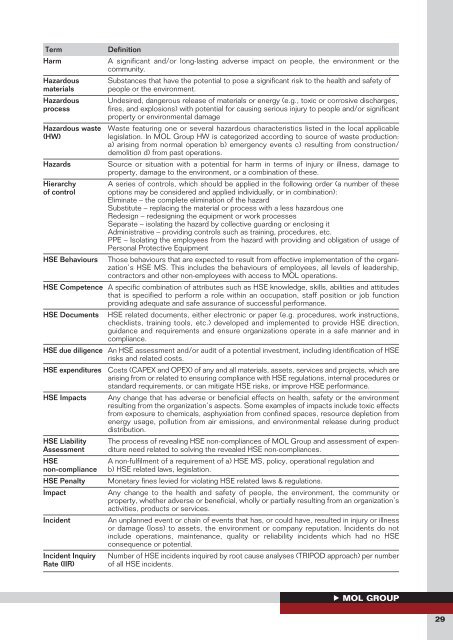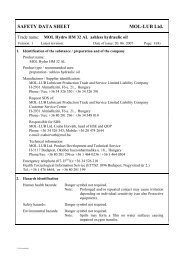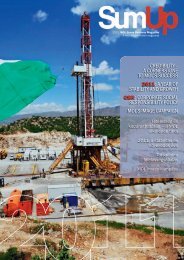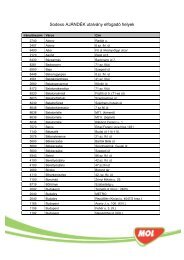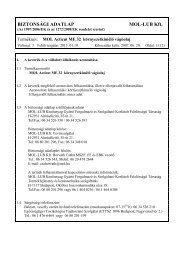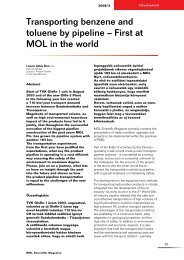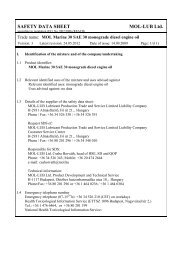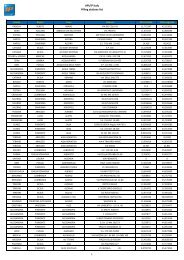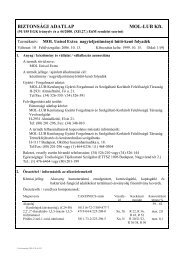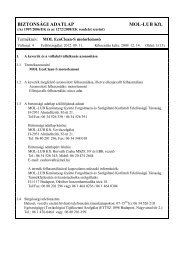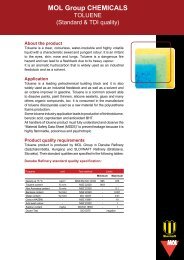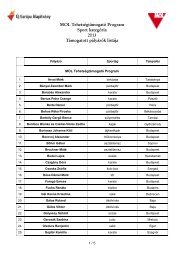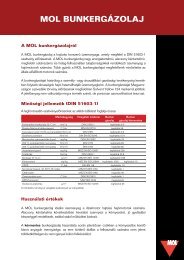HSE Management System (HSE _1 Group Guideline ... - Mol
HSE Management System (HSE _1 Group Guideline ... - Mol
HSE Management System (HSE _1 Group Guideline ... - Mol
Create successful ePaper yourself
Turn your PDF publications into a flip-book with our unique Google optimized e-Paper software.
Term<br />
Harm<br />
Hazardous<br />
materials<br />
Hazardous<br />
process<br />
Hazardous waste<br />
(HW)<br />
Hazards<br />
Hierarchy<br />
of control<br />
Definition<br />
A significant and/or long-lasting adverse impact on people, the environment or the<br />
community.<br />
Substances that have the potential to pose a significant risk to the health and safety of<br />
people or the environment.<br />
Undesired, dangerous release of materials or energy (e.g., toxic or corrosive discharges,<br />
fires, and explosions) with potential for causing serious injury to people and/or significant<br />
property or environmental damage<br />
Waste featuring one or several hazardous characteristics listed in the local applicable<br />
legislation. In MOL <strong>Group</strong> HW is categorized according to source of waste production:<br />
a) arising from normal operation b) emergency events c) resulting from construction/<br />
demolition d) from past operations.<br />
Source or situation with a potential for harm in terms of injury or illness, damage to<br />
property, damage to the environment, or a combination of these.<br />
A series of controls, which should be applied in the following order (a number of these<br />
options may be considered and applied individually, or in combination):<br />
Eliminate – the complete elimination of the hazard<br />
Substitute – replacing the material or process with a less hazardous one<br />
Redesign – redesigning the equipment or work processes<br />
Separate – isolating the hazard by collective guarding or enclosing it<br />
Administrative – providing controls such as training, procedures, etc.<br />
PPE – Isolating the employees from the hazard with providing and obligation of usage of<br />
Personal Protective Equipment<br />
<strong>HSE</strong> Behaviours Those behaviours that are expected to result from effective implementation of the organization’s<br />
<strong>HSE</strong> MS. This includes the behaviours of employees, all levels of leadership,<br />
contractors and other non-employees with access to MOL operations.<br />
<strong>HSE</strong> Competence A specific combination of attributes such as <strong>HSE</strong> knowledge, skills, abilities and attitudes<br />
that is specified to perform a role within an occupation, staff position or job function<br />
providing adequate and safe assurance of successful performance.<br />
<strong>HSE</strong> Documents <strong>HSE</strong> related documents, either electronic or paper (e.g. procedures, work instructions,<br />
checklists, training tools, etc.) developed and implemented to provide <strong>HSE</strong> direction,<br />
guidance and requirements and ensure organizations operate in a safe manner and in<br />
compliance.<br />
<strong>HSE</strong> due diligence An <strong>HSE</strong> assessment and/or audit of a potential investment, including identification of <strong>HSE</strong><br />
risks and related costs.<br />
<strong>HSE</strong> expenditures Costs (CAPEX and OPEX) of any and all materials, assets, services and projects, which are<br />
arising from or related to ensuring compliance with <strong>HSE</strong> regulations, internal procedures or<br />
standard requirements, or can mitigate <strong>HSE</strong> risks, or improve <strong>HSE</strong> performance.<br />
<strong>HSE</strong> Impacts<br />
<strong>HSE</strong> Liability<br />
Assessment<br />
<strong>HSE</strong><br />
non-compliance<br />
<strong>HSE</strong> Penalty<br />
Impact<br />
Incident<br />
Incident Inquiry<br />
Rate (IIR)<br />
Any change that has adverse or beneficial effects on health, safety or the environment<br />
resulting from the organization’s aspects. Some examples of impacts include toxic effects<br />
from exposure to chemicals, asphyxiation from confined spaces, resource depletion from<br />
energy usage, pollution from air emissions, and environmental release during product<br />
distribution.<br />
The process of revealing <strong>HSE</strong> non-compliances of MOL <strong>Group</strong> and assessment of expenditure<br />
need related to solving the revealed <strong>HSE</strong> non-compliances.<br />
A non-fulfilment of a requirement of a) <strong>HSE</strong> MS, policy, operational regulation and<br />
b) <strong>HSE</strong> related laws, legislation.<br />
Monetary fines levied for violating <strong>HSE</strong> related laws & regulations.<br />
Any change to the health and safety of people, the environment, the community or<br />
property, whether adverse or beneficial, wholly or partially resulting from an organization’s<br />
activities, products or services.<br />
An unplanned event or chain of events that has, or could have, resulted in injury or illness<br />
or damage (loss) to assets, the environment or company reputation. Incidents do not<br />
include operations, maintenance, quality or reliability incidents which had no <strong>HSE</strong><br />
consequence or potential.<br />
Number of <strong>HSE</strong> incidents inquired by root cause analyses (TRIPOD approach) per number<br />
of all <strong>HSE</strong> incidents.<br />
29


